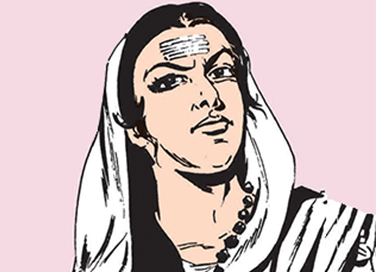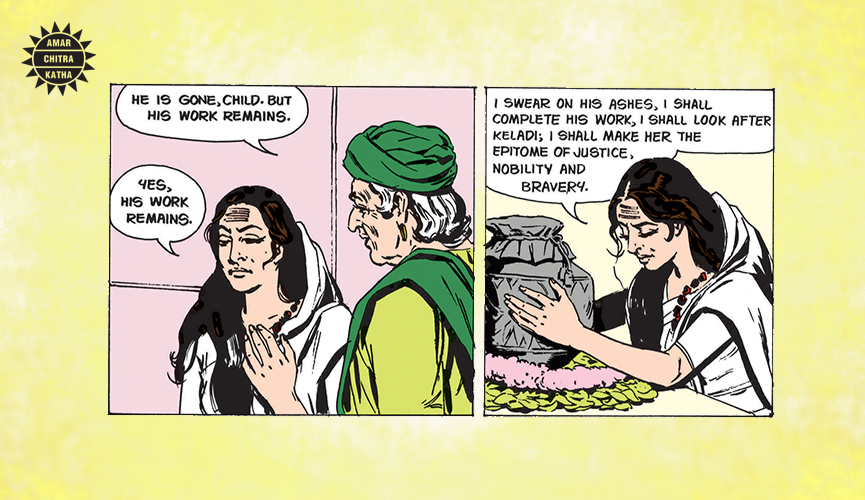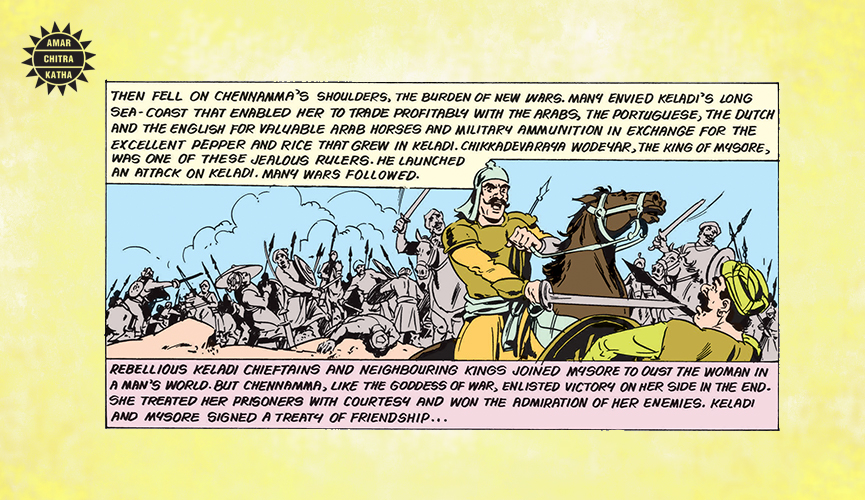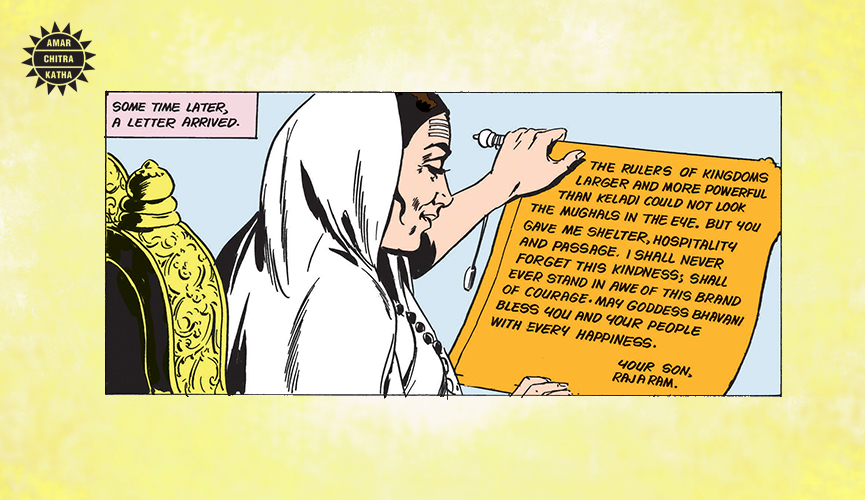Chennamma, the Rani of Keladi
- September 30, 2022


Chennamma, the Rani of Keladi
- September 30, 2022
By Srinidhi Murthy
Chennamma, the queen of Keladi, effectively took over the administration of Keladi after her husband’s death. She reigned justly for over 25 years. Read on to know how this determined queen saved both Rajaram, the son of Chhatrapati Shivaji, and Keladi from the wrath of Aurangzeb.
Somashekhara Nayak was the king of Keladi, a kingdom in the Malnad area. In 1663, at the behest of his ministers, the king married young Chennamma, the daughter of a merchant, in a joyful wedding ceremony. However, there was one man who was unhappy with the royal marriage – Bharama Mahuta, a close friend of the king – who was secretly gathering support to seize the throne. He was worried that this marriage would provide an heir to King Somashekhara, thus foiling his plans. Years passed and the young Chennamma grew into a confident, wise and able queen.
To receive more such stories in your Inbox & WhatsApp, Please share your Email and Mobile number.
The couple was happy, but the king longed for a child who would be his heir. Somashekara Nayak shared his worries with Bharama Mahuta. Devious Bharama saw this as an opportunity to manipulate the king. He convinced the king that he could obtain an heir by drinking a secret potion. Somashekhara Nayak was to leave for war soon and Bharama assured him that the potion would be ready by the time he came back. After a few weeks, the king returned triumphantly and received a warm welcome at home, after conquering the kingdom of Belur and Kannatur. That night, Bharama Mahuta gave the king his potion before he retired to his bed.
The king woke up delirious and screaming in the middle of the night. The horrified Chennamma immediately summoned the physician. As he took his dying breaths, the king whispered about his need for an heir and the potion, alerting Chennamma to foul play. The next morning, Chennamma summoned Bharama Mahuta and had him arrested for the king’s murder. She bitterly told the terrified Bharama that he had become a traitor after he poisoned the king and he too would meet death for his terrible sins. Although she was in mourning for her husband, Chennamma knew that she was now responsible for the safety and well-being of the citizens of Kelad and that she must take charge soon.

Over the next few weeks, every powerful minister proposed a different successor to the queen. Though the queen promised that she would consider each of their proposals carefully, the ministers became impatient and plotted to remove Chennamma from the throne. Amidst this chaos, the queen received news from her spies that the Bijapur army was on its way to attack Keladi. Chennamma tried to convince her council that their first priority at such a time was to repel the invader, not decide the next ruler of Keladi. However, Thimmanna Nayak, the commander-in-chief, walked out of the meeting, declaring that he could not fight for a kingdom without a ruler. Chennamma did not give up. She appealed directly to the army and the people and encouraged them to fight for Keladi. She also informed them that she would fight for her kingdom alongside them. Motivated by the queen’s speech, the people and the army of Keladi fought bravely against the huge army of Bijapur. Despite their efforts, the Bijapur army forced its way through and captured the Bidanpur fort. When the army entered the vanquished city, they realised that the queen had escaped with her citizens along with the jewels and money in the royal treasury.
Chennamma, with her people, took refuge in the fortress of Bhuvanagiri, deep in the forest. One day, the queen was surprised to see Thimmanna Nayak in her fortress. The commander-in-chief apologised for his behaviour and sought the queen’s forgiveness. Chennamma forgave him and Thimmanna gathered the chieftains and citizens from the surrounding parts of Bhuvanagiri and trained them for the war against the Bijapur army. Soon, the Keladi army attacked their enemy and freed Bidanpur from the captors. In 1971, Chennamma was crowned the queen of Keladi. She later adopted a young boy, Basava Nayaka, and trained him to become the next ruler of Keladi. Meanwhile, rebellious Keladi chieftains and neighbouring kings, joined hands with Chikkadevaraya Wodeyar, the king of Mysore, and planned various attacks on Keladi. Chennamma fought back bravely and won numerous wars against the Mysore army. The Queen treated her prisoners kindly and won the admiration of her enemies. Finally, Keladi and Mysore signed a treaty of friendship, which brought peace and harmony between the two kingdoms.

One day, during her daily alms-giving, Chennamma saw a young monk approaching her. The monk bowed to her and introduced himself as Rajaram, son of Chhatrapati Shivaji. He told her that the Mughal emperor, Aurangazeb had sent an army to kill him after he had killed his step-brother, Sambhaji. Rajaram also added that every southern ruler had denied him permission to pass through their kingdom for the fear of Aurangazeb. He requested the queen to permit him to pass through her kingdom, and seek temporary refuge in the fort of Jinji. Chennamma agreed. Soon, the Mughal army, under Jaan Nisar Khan, marched towards Keladi to find Rajaram. Aurangazeb also sent Chennamma a letter threatening her and asking her to surrender Rajaram. Chennamma boldly responded, informing Aurangzeb that Rajaram was not in her kingdom and that he had passed safely through Keladi. Before the queen’s letter could reach Aurangazeb, the Mughal army attacked Keladi.
The Keladi soldiers fought bravely against the Mughal invasion. Soon, the war was halted due to heavy rains. Along with the rains, the unfamiliar forest areas and illness among their soldiers became a major setback for the Mughals. One day, Jann Nisar Khan received a message from Aurangazeb, informing him that Rajaram was in Jinji. The Mughals decided to proceed to Jinji instead and therefore proposed a peace treaty with Keladi. Chennamma was relieved that her kingdom was safe. She knew that Jinji was well fortified and prayed for Rajaram’s safety.

Sometime later, Rajaram wrote a grateful letter to the queen, thanking her for giving him shelter, hospitality, and the passage which even the rulers of larger kingdoms had refused. Chennamma ruled Keladi justly for 25 years and was succeeded by her son, Basava Nayaka.
To receive more such stories in your Inbox & WhatsApp, Please share your Email and Mobile number.

Comic of The Month
The Naval Journey of India Book I
This book is the first of a three-book series that takes a deep and detailed look at India's Naval History and a deep insight into the lives of our men and women in white. But any series on the Indian Navy has to start at the very beginning - exploring India's celebrated maritime history. Join our little hero, Bharat, and his grandfather, Commodore Sagar, as they sail into the deep blue waters of time. Book I of The Naval Journey of India takes a sweeping look at India's maritime endeavours, how the seas impacted us over millennia and how the oceans made us who we are.